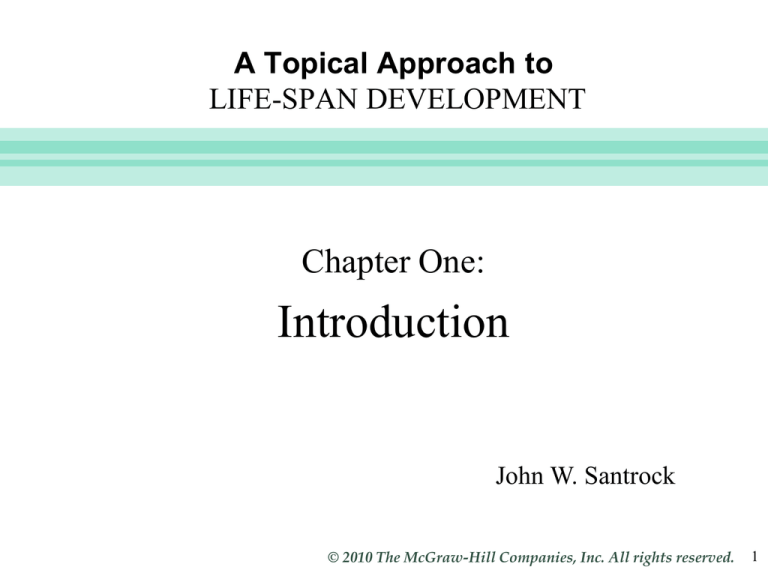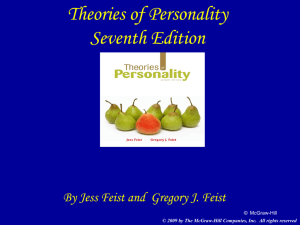
Slide 1
A Topical Approach to
LIFE-SPAN DEVELOPMENT
Chapter One:
Introduction
John W. Santrock
© 2010 The McGraw-Hill Companies, Inc. All rights reserved.
1
Slide 2
The Life-Span Perspective
• The Importance of Studying Life-Span
Development
• The Historical Perspective
• Characteristics of the Life-Span Perspective
• Development — pattern of change that
begins at conception and continues through
life span
© 2010 The McGraw-Hill Companies, Inc. All rights reserved.
2
Slide 3
Importance of Studying Life-Span
Development
• Experiences influence development
– Maximum human life span unchanged
– Life expectancy — average number of years a
person is expected to live when born in a
particular year has changed
– Developmental change occurs during adulthood
as well as childhood
© 2010 The McGraw-Hill Companies, Inc. All rights reserved.
3
Slide 4
Importance of Studying Life-Span
Development
• Characteristics of the Life-Span Perspective
–
–
–
–
–
Lifelong
Multidimensional
Multidirectional
Plastic
Multidisciplinary
–
–
–
–
Contextual
Growth
Maintenance
Regulation of loss
© 2010 The McGraw-Hill Companies, Inc. All rights reserved.
4
Slide 5
Importance of Studying Life-Span
Development
• Development is contextual
– Normative age-graded influences
• Shared by a particular age group
– Normative history-graded influences
• Shared by a specific generation
– Nonnormative life events
• Unique to the individual
© 2010 The McGraw-Hill Companies, Inc. All rights reserved.
5
Slide 6
Importance of Studying Life-Span
Development
• Some contemporary concerns:
– Health and well-being
– Parenting and education
• Sociocultural contexts and diversity
–
–
–
–
Culture
Ethnicity
Socioeconomic status
Gender
© 2010 The McGraw-Hill Companies, Inc. All rights reserved.
6
Slide 7
Importance of Studying Life-Span
Development
• Social policy — laws, regulations, and
government programs that influence citizens’
welfare
– U.S. family policies overwhelmingly treatment
oriented
© 2010 The McGraw-Hill Companies, Inc. All rights reserved.
7
Slide 8
The Aging of America
Fig. 1.5
© 2010 The McGraw-Hill Companies, Inc. All rights reserved.
8
Slide 9
Processes in Development
Fig. 1.6
© 2010 The McGraw-Hill Companies, Inc. All rights reserved.
9
Slide 10
Nature of Development
• Development period — time frame in one’s
life characterized by certain events
– Interplay of biological, cognitive, and sociological
processes
– Each period has its own stresses, ups and downs,
and concerns
– Variations in capabilities of same age individuals
occur in all periods of development
© 2010 The McGraw-Hill Companies, Inc. All rights reserved. 10
Slide 11
Nature of Development
• Periods of development
•
•
•
•
Prenatal Period
Infancy
Early childhood
Middle and late
childhood
•
•
•
•
Adolescence
Early adulthood
Middle adulthood
Late adulthood
© 2010 The McGraw-Hill Companies, Inc. All rights reserved. 11
Slide 12
Nature of Development
• Significance of age
– Age and happiness
• Some studies — no differences for each age group
• Some found “U-shaped” results — lowest happiness at
30-40 years of age
• U.S. research — happiness increases with age
© 2010 The McGraw-Hill Companies, Inc. All rights reserved. 12
Slide 13
Nature of Development
• Conceptions of age
– Chronological age — number of years elapsed
since person’s birth
– Biological age — in terms of biological health
– Psychological age — one’s adaptive capacities
– Social age — social roles and expectations
related to one’s age
© 2010 The McGraw-Hill Companies, Inc. All rights reserved. 13
Slide 14
Nature of Development
• Developmental issues
– Nature and nurture
• Inheritance or environment?
– Stability and change
• Traits and characteristics; capacity for change?
– Continuity and discontinuity
• Gradual or abrupt changes in development?
© 2010 The McGraw-Hill Companies, Inc. All rights reserved. 14
Slide 15
Continuity and
Discontinuity
in
Development
Fig. 1.9
© 2010 The McGraw-Hill Companies, Inc. All rights reserved. 15
Slide 16
Theories of Development
• Theory — interrelated set of ideas that helps
to explain data, make predictions
• Hypotheses — assertions or predictions,
often derived from theories that can be tested
© 2010 The McGraw-Hill Companies, Inc. All rights reserved. 16
Slide 17
Theories of Development
• Psychoanalytic Theories
– Development is primarily unconscious, heavy with
emotion
– Behavior is surface characteristic of development
– Analyze symbolic meanings of behavior and deep
inner workings of the mind for true meaning of
development
– Early childhood experiences stressed (ages 1-5)
© 2010 The McGraw-Hill Companies, Inc. All rights reserved. 17
Slide 18
Theories of Development
• Freud’s theory
–
–
–
–
–
Id, ego, and superego create personality
Defense mechanisms and repression
Anxiety and defense mechanisms
Five stages of psychosexual development
Criticisms: overemphasized sexual instincts,
unconscious is more important today
© 2010 The McGraw-Hill Companies, Inc. All rights reserved. 18
Slide 19
Freudian Stages
Fig. 1.10
© 2010 The McGraw-Hill Companies, Inc. All rights reserved. 19
Slide 20
Theories of Development
• Erikson’s psychosocial theory
– Primary motive for human behavior is social;
desire to affiliate with others
– Developmental changes throughout life span
– Experiences at all ages are important
– Criticisms: stages have positive/negative poles,
crisis in each stage needs resolution
© 2010 The McGraw-Hill Companies, Inc. All rights reserved. 20
Slide 21
Erikson’s Eight Life-Span Stages
© 2010 The McGraw-Hill Companies, Inc. All rights reserved. 21
Slide 22
Theories of Development
• Cognitive Theories
– Emphasize conscious thoughts
– Three major theories
• Piaget’s cognitive development
• Vygotsky’s sociocultural cognitive theory
• Information processing theory
© 2010 The McGraw-Hill Companies, Inc. All rights reserved. 22
Slide 23
Theories of Development
• Piaget’s cognitive developmental theory
– Children actively construct their knowledge
– Each of the four stages
•
•
•
•
Age-related
Has a distinct way of thinking
Has different way of understanding the world
Child’s cognition is “qualitatively” different
© 2010 The McGraw-Hill Companies, Inc. All rights reserved. 23
Slide 24
Piaget’s Four Stages of Cognitive
Development
Fig. 1.12
© 2010 The McGraw-Hill Companies, Inc. All rights reserved. 24
Slide 25
Theories of Development
• Vygotsky’s sociocultural cognitive theory
– Children actively construct their knowledge
– Culture and social interaction guide cognitive
development
• Learning to use inventions of society
• Learning from social interactions with more skilled adults
and peers
• Interaction creates tools to adapt to culture
© 2010 The McGraw-Hill Companies, Inc. All rights reserved. 25
Slide 26
Theories of Development
• Information-Processing theory
– Brain is compared to computer’s hardware
– Cognition is viewed as computer software
– Individuals acquire increasingly complex
information
– Thinking: perceive, encode, represent, store, and
retrieve information
– Good strategies: important to development
© 2010 The McGraw-Hill Companies, Inc. All rights reserved. 26
Slide 27
Information-Processing Theory
culture
literature
science
INPUT
history
OUTPUT
religion
math
© 2010 The McGraw-Hill Companies, Inc. All rights reserved. 27
Slide 28
Theories of Development
• Behavioral and Social Cognitive Theories
– Behaviorism — scientific studies can only be
based on direct observations and measures
– Development is observable behavior
• Learned from experiences/environment
• Development does not occur in stages; advocates
continuity
© 2010 The McGraw-Hill Companies, Inc. All rights reserved. 28
Slide 29
Theories of Development
• Skinner’s operant conditioning
– Consequences, rewards and punishment, shape
behavior
• No emphasis on thoughts, feelings
– Development is pattern of behavioral changes
• Modifying environment produces change
• Changes determined by consistency experiences,
rewards or punishments
© 2010 The McGraw-Hill Companies, Inc. All rights reserved. 29
Slide 30
Theories of Development
• Bandura’s social cognitive theory
– Behavior, environment, and cognition are key to
development
– Behavior is learned through observation and
imitating (modeling)
– Behavior of others is cognitively evaluated,
strategies created for successful learning
© 2010 The McGraw-Hill Companies, Inc. All rights reserved. 30
Slide 31
Bandura’s Social Cognitive Model
Fig. 1.13
© 2010 The McGraw-Hill Companies, Inc. All rights reserved. 31
Slide 32
Theories of Development
• Ethological Theory
– Emphasis on biology and evolution, sensitive
periods of development, and careful observations
– Lorenz: imprinting
• Animals’ rapid, innate learning process involving
“attachment”
• Critical period is early in life
© 2010 The McGraw-Hill Companies, Inc. All rights reserved. 32
Slide 33
Theories of Development
• Ethological Theory
– Bowlby
•
•
•
•
•
Used ideas of Lorenz
“Attachment” determines development
Positive and secure, negative and insecure
Sensitive period is in infancy
Promotes good social relationships
© 2010 The McGraw-Hill Companies, Inc. All rights reserved. 33
Slide 34
Theories of Development
• Ecological theory
– Bronfenbrenner’s view that development
influenced by five environmental system
•
•
•
•
•
Microsystem
Mesosystem
Exosystem
Macrosystem
Chronosystem
© 2010 The McGraw-Hill Companies, Inc. All rights reserved. 34
Slide 35
Bronfenbrenner’s Ecological Theory
Fig. 1.14
© 2010 The McGraw-Hill Companies, Inc. All rights reserved. 35
Slide 36
Theories of Development
• Eclectic theoretical approach
– Life-span development is complex
– Each theory has contribution to understanding
development
• Selects from best features of each
– A mistake to rely on only one theory
© 2010 The McGraw-Hill Companies, Inc. All rights reserved. 36
Slide 37
Research in Life-Span Development
• Methods for Collecting Data
– Observation:
• Laboratory
• Naturalistic observation
– Cultural concerns
– Survey and interview
• Self-report, clear and unbiased questions
© 2010 The McGraw-Hill Companies, Inc. All rights reserved. 37
Slide 38
Research in Life-Span Development
• Methods for Collecting Data
– Standardized test
– Case study
• Focus on aspects of individual’s life
• Unique, cannot be duplicated
– Physiological measures
• Blood tests, MRI
© 2010 The McGraw-Hill Companies, Inc. All rights reserved. 38
Slide 39
Research in Life-Span Development
• Methods for Collecting Data
– Descriptive research:
• Observe and record
– Correlational research:
• Prediction based on strength of relationship
• Correlation coefficient (+1.00 to -1.00)
© 2010 The McGraw-Hill Companies, Inc. All rights reserved. 39
Slide 40
Possible Explanations for
Correlational Data
Fig. 1.19
© 2010 The McGraw-Hill Companies, Inc. All rights reserved. 40
Slide 41
Research in Life-Span Development
• Methods for Collecting Data
– Experimental research
•
•
•
•
•
Causality and effect
Dependent (Y) and independent (X) variables
Control and experimental groups
Random assignment of subjects
Manipulation of independent (X) variable
© 2010 The McGraw-Hill Companies, Inc. All rights reserved. 41
Slide 42
Principles of Experimental Research
Fig. 1.18
© 2010 The McGraw-Hill Companies, Inc. All rights reserved. 42
Slide 43
Research in Life-Span Development
• Time Span of Research
– Cross-sectional approach
• Compares different age groups at the same time on a
variety of dependent variables
– Longitudinal approach
• Studies same group over long period of time
– Cohort effects: time of birth, generation, era
© 2010 The McGraw-Hill Companies, Inc. All rights reserved. 43
Slide 44
Research in Life-Span Development
• Research Journals
–
–
–
–
–
Learning about journal process is beneficial
Scholarly and academic information published
Articles evaluated before publishing
Some journals more prestigious than others
Organization of article
• Abstract, introduction, method, results, discussion,
references
© 2010 The McGraw-Hill Companies, Inc. All rights reserved. 44
Slide 45
Research in Life-Span Development
• Conducting Ethical Research
– APA guidelines address
• Informed consent, confidentiality
• Debriefing, deception
– Minimizing bias (gender, culture, ethnicity)
• Ethnic gloss — overgeneralizing about ethnic group(s)
© 2010 The McGraw-Hill Companies, Inc. All rights reserved. 45
Slide 46
The End
© 2010 The McGraw-Hill Companies, Inc. All rights reserved. 46









